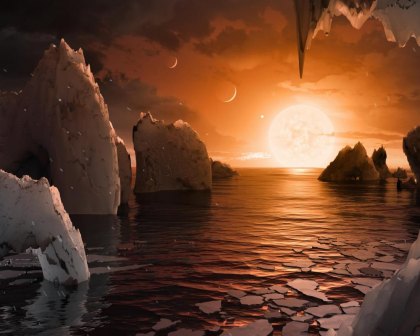Scientists find seven planets around star

This is the first known system with so many Earth sized planets around a single star, and during a televised press conference today, scientists admitted that they were excited.
“The discovery gives us a hint that finding a second Earth is not just a matter of if but when,” said Thomas Zurbuchen, associate administrator of the science mission directorate at NASA headquarters in Washington, D.C.
The system is known as TRAPPIST-1, named for The Transiting Planets and Planetesimals Small Telescope (TRAPPIST) in Chile, according to NASA. A paper detailing the findings has been published in the journal Nature and was led by Michael Gillon, astronomer at the University of Liege in Belgium.
About the planets: The planets are orbiting so closely to the star that they may be “tidally locked,” explained Gillon during the press conference. “They always face the star to the same side, like the moon to the Earth.”
The three worlds in the habitable zone are all believed to be rocky. "For one of them, our measurement is precise enough to strongly suggests a water-rich composition," he said, "which is very exciting because this is one of the planets in the habitable zone."
The first planet in the habitable zone is called TRAPPIST 1-E and is close in size to Earth. It orbits the star in six days. "It also receives about the same amount of light that Earth does in our own solar system,” explained Nikole Lewis, astronomer at the Space Telescope Science Institute in Baltimore. “This means that on TRAPPIST 1-E, you could have temperatures that are very similar to the ones we have on Earth.”
The next planet, designated TRAPPIST 1-F, is the one believed to be a "potentially water-rich world," Lewis said. It receives about the same amount of sunlight as Mars and has a nine-day orbit.
The final planet in the habitable zone, TRAPPIST 1-G, is bigger than the others – with a radius about 13 percent larger than Earth. It receives about the same amount of sunlight found between Mars and the asteroid belt in our solar system, Lewis said. It orbits the star in about 12 days.
The star: It is much smaller than our sun and is referred to by scientists as an "ultra-cool dwarf" star. Its brightness makes it an ideal candidate for the Spitzer telescope, which was used by researchers, explained Sean Carey, manager of NASA's Spitzer Science Center in Pasadena, California.
The habitable zone of a star is the area around it in which a rocky planet is most likely to have liquid water. It can be different depending on the size of the star. In this case, the planets are closer to their star than Mercury is to the sun, according to NASA.
Scientists believe some planets in the habitable zones of their stars do not support life because of stellar eruptions. "Ultra-cool dwarfs are known to be very active when they are young," Gillon said. "This is the main concern about these potentially habitable planets. They (the planets' atmospheres) could have been eroded strongly by the star when it (the star) was young. Now it is quiet. ...So it is not very active. But maybe when it was young, the conditions were quite different. It will be by observation that we will really figure out the past of these planets and what happened during this very active and young phase."
How long it would take to travel to these planets: If it were possible to travel at light speed, the trip would take 39 years. But as that’s not an option, the trip would take longer, according to Lewis. “Something more like a jet plane would take far longer,” she says. “It would be more along the line of 44 million years.”
The significance: “With these discoveries, we’ve made a giant, accelerated leap forward in the search for habitable worlds and life on other worlds potentially speaking,” said Sara Seager, professor of planetary science and physics at Massachusetts Institute of Technology, Cambridge.
In addition, this solar system presents a chance to study planets orbiting cool, dim stars. In 2018, NASA plans to launch another observatory, the James Webb Space Telescope. “The reason the TRAPPIST planets are so significant is that they are accessible to observations with the James Webb Space Telescope. ... With the James Webb, we’ll be able to study the atmospheres,” Seager said.
Scientists may also learn about the planets’ greenhouse gas content, which will help them understand the surface temperatures, she added. “Are they indeed the right temperatures to support liquid water and life as we know it?”
The James Webb telescope may also help scientists search for gases that might be produced by life.
Seager then explained, "Admittedly, we have no way to easily give official names to exoplanets in the same way that we do for asteroids. But perhaps that's something we should try to change."
So how many habitable exoplanets have been found, including this discovery? The answer depends on who you ask and how you count them, Seager explained. "We would say that there are, let's say, a few dozen exoplanets that you might consider habitable," she said, "but the bottom line is that many of them may be a bit too hot or a bit too big. We really have to wait until we can see the atmospheres to know how hot or cold the planets really are. That's why the TRAPPIST planets are so relevant, because. .. unlike a lot of the other habitable zone planets, we can actually assess them in the near future."
Related:
Citizen scientists sought to identify planets
Telescope spots 1,284 new planets
Scientists: Water possible on three planets
NASA marks verification of 1,000th planet
Planet in habitable zone orbits sunlike star
Follow StudyHall.Rocks on Twitter.
If you would like to comment, give us a shout, or like us on Facebook and tell us what you think.

